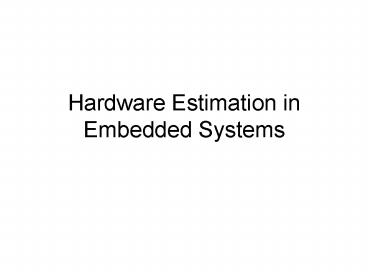Hardware Estimation in Embedded Systems PowerPoint PPT Presentation
1 / 23
Title: Hardware Estimation in Embedded Systems
1
Hardware Estimation in Embedded Systems
2
Motivation
- A computation intensive part of application is
mapped to hardware. - Cost of embedding depends on various metrics like
functional elements used ,memory elements
,interconnects and execution time. - Keeping the above metrics in mind various
alternatives in design space have to be explored.
3
Contd
- Finally the best suited to the end user can be
synthesised. - To make this partition decision a cost estimate
of various alternatives is required.
4
Objective
- Given a C application estimate the cost in terms
of chip area (functional units etc). - Characteristics of estimator required
- Speed
- Fidelity
- Accuracy
5
Performance Metrics
- Data Storage registers (files or distributed),
functional units (pipelined or non-pipelined),
size and level of cache. - Optimum Clock minimize the idle time of FU which
in turn will minimize the execution time.
6
Contd
- Area Datapath, Control Units and Interconnects.
- Communication Rate and Number of pins depends on
frequency of external accesses and data width
7
SUIF Compiler
- SUIF is used, as here different passes are
implemented as separate programs. - Each pass performs analysis or transformation and
then writes back its output to a file. - Makes it easy to reorder or insert new passes.
8
Information Extractor Module
- It traverses the SUIF tree and generates a
Control Data Flow Graph (CDFG) and a list of all
the operations. - When the IE encounters a condition (like if,
while) it inserts a new node in the CDFG and
assigns a suitable operation type depending upon
the instruction.
9
Profiler
- It is used to determine execution frequencies of
different Basic Blocks to obtain an estimate of
total execution time. - These frequencies are data dependent.
10
Clock Estimation
- Aim is to minimize the slack or the idle time of
FUs. - To increase accuracy number of occurrences of
each operation type is taken into account. - Firstly clk_min and clk_max are determined based
on delays of various FUs that will implement
operations in the behavior.
11
Contd..
- Then along the critical path frequency of
occurrence of various operations is obtained. - Avg_slack(clk) sum(occur(ti)slack(clk,ti
))/sum(occur(ti)) - An operator with large delay but a small
occurrence count cannot influence arbitrarily.
12
Execution Time Estimation
- This estimate helps to eliminate totally
redundant designs, hence reducing the design
space of an embedded system. - Exectime(B)sum(exectime(bi)freq(bi))
where exectime(bi)csteps(bi)clk - Csteps(nj,ti)max((occur(ti)/num(ti))clk,
num(ti)p(ti)portus(ti)/(rfp
memp))
13
Contd..
- Since the above algo. does not ensure maximum use
of FUs or of available read, write ports at a
given instant. - A new algo. Resource Use Method was developed
and implemented. - As in List Scheduling a ready list which is a
set of data independent operations is obtained.
14
Contd
- While all the operations are not scheduled,
shecdule_operation is called if read_ports are
available and FU is available. - Priority functiondelay(ti)traffic(ti)/num(ti)
- Further it is observed that the choice of
priority is application dependent.
15
Lower Bound Estimate
- By implementing scheduling algos.
- For each resource type t, operations of that type
are grouped into three non-overlapping intervals
and then a lower bound is computed on the sum of
lengths of those intervals. - The final lower bound is maximum among all
resource types and all possible groupings of
operations of that type.
16
Contd..
- MSAT(v) is defined as the minimum number of steps
that any schedule of DFG G is going to take after
the completion of operation v, assuming unlimited
resources. - ASAP is the earliest time step at which v can be
scheduled to start execution. - Critical path length is maxvASAP(v)dv-1
17
Contd
- Pt number of operations of type t in DFG
- SA(i,t) operations of type t with ASAP value
less than or equal to i. - Then there are at least Pt-SA(i,t) type t
operations that cannot be scheduled in the first
i time steps. - SM(j,t) operations of type t with MSAT value
less than or equal to j.
18
Contd..
- Then there are at least Pt-SM(i,t) type t
operations that cannot be scheduled in the last j
time steps. - The three intervals considered are first i
steps(I1), last j steps ( interval I3) and
interval (I2) between the two. - The length of I2 depends on the minimum number of
type t operations and the number of resources
available to for type t.
19
Contd..
- A lower bound on the completion of any schedule
is given by max(t,ijltc)h(i,j,t)ij - If n is the number of operations in DFG and c is
the critical path length then time complexity of
above algo. is given by O(nc2).
20
Area
- A weighted sum of functional units area with
number of functional units gives an estimate of
datapath area. - Number of states is given by sum of control steps
in all the basic blocks. - One-hot encoding was used.
- FPGA was used as target technology for
implementation of schedule.
21
Contd
- Number of LUTs required to realize logic for a
state depends on the number of ways that state
can be reached. - CLB(LUT)(total no. of LUT)/(no. of LUT
per CLB)
22
Storage Area
- Mutually exclusive operations of the same type
can always share an FU, even if they are
scheduled in the same time step. - Based on CDFG an AND-OR representation is
obtained which makes it convenient to estimate
the number of registers in a bottom-up manner.
23
Contd..
- An AND node of the AND-OR tree represents one
branch of a Conditional Construct (CC) and an OR
node represents all the branches of a CC.

